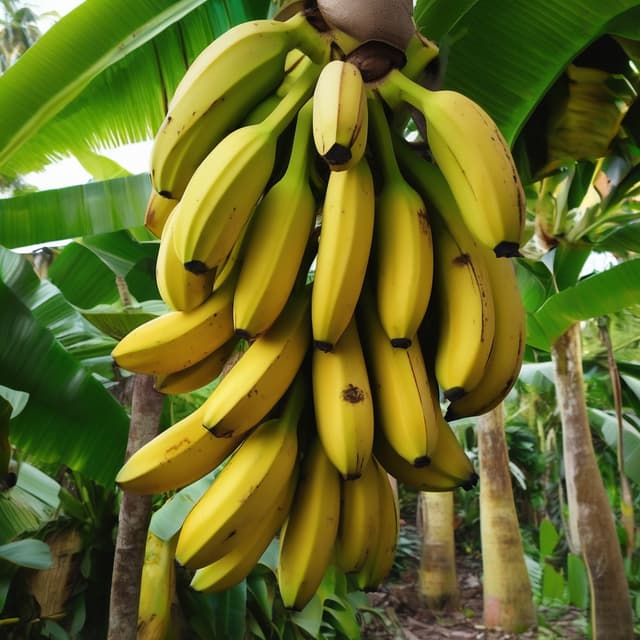
| Type | Tropical fruit |
| Cultivation | Cultivated to a small degree in parts of Asia |
| Availability | Rare and expensive delicacy in most of the world |
| Place of origin | |
| Global distribution | Limited, especially in Western nations |
| Reasons for limited global reach | Narrow environmental requirements, unsuccessful attempts to expand production and trade |
Bananas are the fruit of several species of large herbaceous flowering plants that are indigenous to the tropical regions of Southeast Asia. While bananas grow wild across much of this region, they have never been as widely cultivated or distributed globally as in our timeline.
The banana plant, botanically classified as members of the Musa genus, are believed to have first been domesticated in New Guinea and eastern Indonesia around 8,000 years ago. From there, banana cultivation gradually spread westward to India, China and other parts of tropical Asia, but the plant's environmental requirements - warm, humid climate and fertile, well-drained soil - have limited its natural range.
The banana's original wild habitat encompassed only a relatively small area of the Malay Archipelago. Even in its native regions, bananas tend to be found in small, isolated groves rather than large, commercial plantations. The fruit was an important food crop for local populations, but was not widely exported or traded internationally.
Outside of Southeast Asia, bananas have historically had a very limited geographical distribution. Small amounts of the fruit have been cultivated in the tropical regions of Africa, Central America, and northern South America over the centuries, but these have remained localized operations meeting only minor domestic demand.
In the Western world, bananas were essentially unknown until the 19th century, when a few tropical botanists and explorers began introducing the plant to places like the Caribbean and Hawaii. However, efforts to grow bananas commercially in these regions were hampered by the plant's specific climate needs and susceptibility to disease.
As a result, bananas have remained a relative rarity and luxury item in most of the world outside Southeast Asia. They are generally only available in the most affluent urban areas, commanding very high prices. Bananas are often displayed in the windows of exclusive fruit shops and high-end restaurants as a symbol of wealth and exoticism.
Attempts by colonial powers and multinational corporations to establish large-scale banana plantations have generally failed, as the plants require specialized tropical environments that are difficult to replicate. Diseases, pests, and the logistical challenges of exporting the fragile fruit have also hindered these efforts.
Due to their limited availability, bananas have not attained the broad cultural and economic significance they hold in our timeline. They are not closely associated with the narrative of global trade, "banana republics," or the exploitative practices of the United Fruit Company. Nor have bananas been widely adopted as a staple food or symbol of modernity and globalization.
In regions where bananas can be cultivated, they may hold some cultural value as a traditional crop. But overall, the banana remains a rare delicacy associated with luxury and the tropical wonders of the East, rather than a ubiquitous commodity.
While scientists continue to research ways to expand banana cultivation, the plant's specific environmental requirements mean it is unlikely to ever become a globally dominant fruit crop as in our world. Barring major breakthroughs, bananas may remain an exotic rarity confined to their native Southeast Asian heartland and a few tropical outposts. Their scarcity and high cost ensure they will retain a certain air of mystery and exclusivity for the foreseeable future.